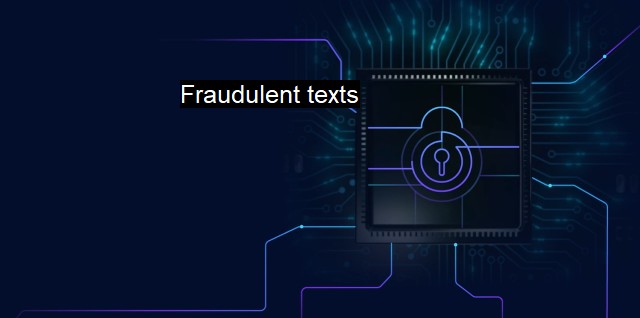What are Fraudulent texts?
Exposed: The Danger of Fraudulent Texts and How Cybercriminals Use SMS to Trick and Defraud Victims
Fraudulent texts, also referred to as smishing or SMS phishing, represent a prevalent form of cybercrime frequently associated with identity theft, financial frauds, and privacy breaches in today's digitally connected world. The objective behind this type of cyber prank is to trick recipients into unknowingly providing sensitive personal, financial, or institutional data.Though the content may vary, fraudulent texts usually involve apparent emergencies, continual account maintenance, additional service offerings, or other captivating measures intended to motivate the individual on the other end to take action without consideration. Cybercriminals may forge these text messages to appear authentic and trustworthy, often separatists as messages from authoritative bodies such as banks, service providers, government agencies, or other common entities one would otherwise not second guess.
Leveraged effectively, a successful fraudulent text can result in unauthorized access to accounts, sudden loss of funds, identity theft, introduction of malware into a device, and disruption of privacy. A hallmark characteristic of cyberattacks, in general, is their rapid rate of evolution. Scammers continuously refine their messaging and tactics to avoid seeming suspicious and bypass implemented security measures.
To combat fraudulent texts, robust cybersecurity and antivirus programs use a multifaceted approach. Initially, algorithms are designed to scan and detect anomalies, suspicious patterns, or known malicious links within text messages received. If potential fraudulent activity is identified, the text may be flagged, blocked or quarantined, with the recipient informed about the appeared threat.
Prominent antivirus operations further bolster their effect by leveraging machine learning principles that poster constant evolution of their detection strategies, much like the scammers themselves. Often pairing with services that maintain databases of reported phishing attempts, these systems function continually to detect newly-emerging threats rapidly.
Besides active protection from cybersecurity programs, cultivating good security habits plays a critical role in combating fraudulent texts. Customers should be educated about the potential threats and ways to distinguish between legitimate and fraudulent messages. This awareness includes scrutinizing unprompted requests for personal information, irrational urgency in messages, and typical indications of deceptive intentions like spelling errors, grammar mistakes, and unfamiliar or suspicious sender information.
While innovation in the digital realm provides countless advantages, it also increases the complexity of the threat landscape and, consequently, the need for holistic, adaptive, and pervasive cybersecurity strategies. In response, antivirus means are continuously researching, innovating, and crafting defenses to keep up with the dynamic risk landscape to protect against fraudulent texts effectively.
With cyber threats on the rise, especially in the form of fraudulent texts, it underscores the criticality of employing robust cybersecurity defenses and being vigilant. Antivirus programs, machine learning-based protective strategies, and digital literacy amongst users collectively can make a significant headway against fraudulent texts. Eliminating such threats entirely may not be practically plausible; their impact can be reduced significantly with a strategic combination of technology, procedural protections, and increased awareness.

Fraudulent texts FAQs
What are fraudulent texts?
Fraudulent texts are text messages that are designed to trick individuals into providing personal or financial information. These texts are often sent by scammers who are seeking to gain access to sensitive information that they can use to steal money or identities.How can I identify a fraudulent text?
Fraudulent texts often contain urgent or alarming messages that are designed to make you act quickly without thinking. They may also ask you to click on a link or provide sensitive information, such as your social security number or bank account information. Be wary of texts from unknown senders or messages that contain spelling or grammar errors.What should I do if I receive a fraudulent text?
If you receive a fraudulent text, do not respond or click on any links. Instead, delete the message and block the number if possible. If you have already clicked on a link or provided sensitive information, contact your bank or credit card company immediately to report any unauthorized charges.How can I protect myself from fraudulent texts?
To protect yourself from fraudulent texts, avoid responding to messages from unknown senders or messages that ask for personal or financial information. Install antivirus software on your smartphone or mobile device, and keep it updated. While antivirus apps cannot catch every malware or phishing attack, they can help detect and remove threats before they cause any damage.| | A | | | B | | | C | | | D | | | E | | | F | | | G | | | H | | | I | | | J | | | K | | | L | | | M | |
| | N | | | O | | | P | | | Q | | | R | | | S | | | T | | | U | | | V | | | W | | | X | | | Y | | | Z | |
| | 1 | | | 2 | | | 3 | | | 4 | | | 7 | | | 8 | | |||||||